BlueMAX™-Series
Selective Catalytic Reduction (SCR) System Features
 Great at reducing deadly emissions, such as Carbon Monoxide (CO), Hydrocarbons (HC) and Nitrogen Oxides (NOx) emissions from your diesel engine
Great at reducing deadly emissions, such as Carbon Monoxide (CO), Hydrocarbons (HC) and Nitrogen Oxides (NOx) emissions from your diesel engine- BlueMAX™ 100 is ideal for Off-road application (construction, mining, material handling), BlueMAX™ 200 – On-road, BlueMAX™ 300 – Power Generation, BlueMAX™ 320 – Marine, BlueMAX™ 350 – Gantry Cranes, BlueMAX™ 420 – Locomotive industry
- US Environmental Protection Agency (EPA) verified system for medium to heavy-duty engines in the off-road application (BlueMAX™ 100)
- Pre-fitted sensors
- A robust structure designed for off-road harsh environment & operating conditions
- System maintenance intervals of 2000 to 5000 hours
- Data logging capabilities & computerized controller with 3 customizable alarms
- Colour display informing of system operating conditions and status
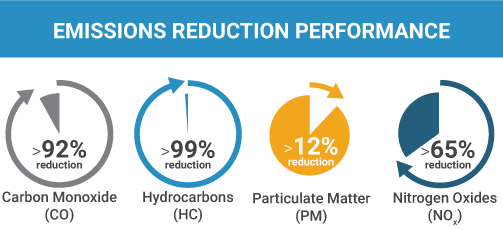
BlueMAX™-Series - Technology
The main components of the BlueMAX™-Series system include the Selective Catalytic Reduction (SCR) catalytic converter, the computerized Urea Dosing System (UDS) and the urea tank (see diagram below). The urea control strategy relies on Nitrogen Oxides (NOx) concentration measurements by a sensor positioned upstream of the Selective Catalytic Reduction (SCR) catalyst. Based on the NOx sensor signal in combination with an engine air mass flow sensor and temperature sensors, the computer calculates the amount of urea which needs to be injected for optimum NOx reductions.
The NOx sensor-based control strategy makes the system very suitable for both original equipment and retrofit applications. System calibration (i.e. engine mapping) is not required and the system can be installed on a wide range of diesel engines, both mechanically and electronically controlled.
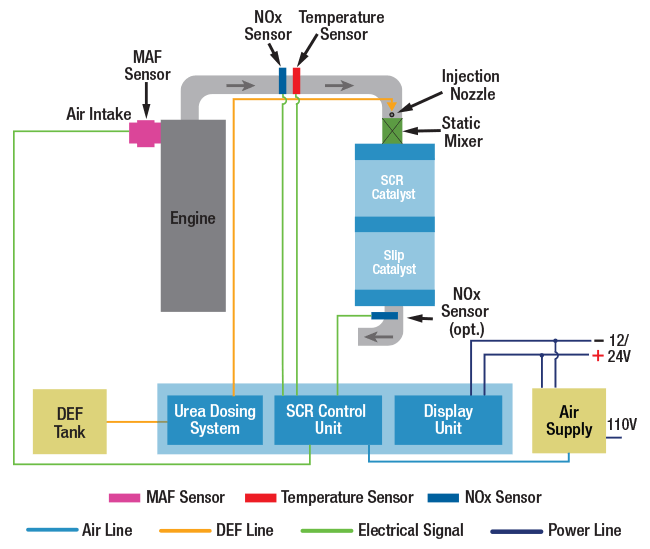
BlueMAX™-Series - Performance
Urea (in the form of a 32.5% water-based solution) is metered by a computer controlled dosing pump into the exhaust pipe upstream of the Selective Catalytic Reduction (SCR) catalyst through an injection nozzle. Compressed air from the air brake line or a standalone air compressor is used to atomize the urea for optimum dispersion, to maximize the Nitrogen Oxides (NOx) reductions and minimize the amount of urea required. The injected urea solution evaporates in the hot exhaust gas and decomposes producing ammonia. Through catalytic reactions with ammonia, NOx emissions are reduced to harmless products including nitrogen and water vapor.
The BlueMAX™-Series system includes an ammonia slip catalyst (oxidation catalyst) as a standard feature. The ammonia slip catalyst prevents the possibility that unreacted ammonia is released from the vehicle tailpipe. The catalyst consists of a metallic monolith honeycomb substrate coated with platinum group metal catalyst. The honeycomb structure with many small parallel channels presents a high catalytic contact area for the exhaust gases. Due to the presence of an oxidation catalyst reductions in Carbon Monoxide (CO) and Hydrocarbon (HC) emissions are achieved in addition to ammonia slip control. Typical conversion efficiency for NOx as well as for CO and HC are illustrated in the graphs below.
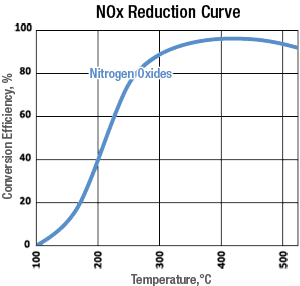


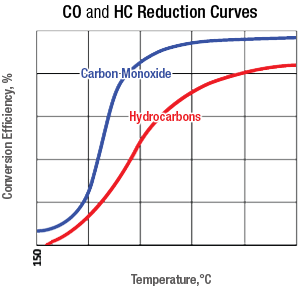


BlueMAX™-Series - Designs and Options
Standard models and sizing charts for the Nett BlueMAX™-Series system are listed in Table 1. Sizing for particular engines and applications should be consulted with our office before ordering.
Nett BlueMAX™-Series Standard Models (GL)
| Max. Engine Power | ||
| Model | hp | kW |
| GL5100 | 100 | 75 |
| GL5200 | 150 | 110 |
| GL5300 | 200 | 150 |
| GL5400 | 250 | 185 |
| GL5500 | 300 | 225 |
| GL5600 | 350 | 260 |
| GL5700 | 400 | 300 |
| GL5800 | 450 | 335 |
| GL5900 | 500 | 370 |
Custom housing designs are available to fit any engine configuration. The Nett BlueMAX™-Series Selective Catalytic Reduction (SCR) system can be supplied with a Diesel Particulate Filter (DPF) for simultaneous NOx and PM control (see BlueMAX™ PLUS, VOLT and NOVA models for more information).
BlueMAX™ 100 - Verification
Nett Technologies Inc. has received US-EPA verification of its BlueMAX™ 100 Selective Catalytic Reduction (SCR) system for controlling NOx emissions from mobile nonroad medium and heavy-duty diesel engines. The verification is a first of its kind issued for retrofit device under EPA ETV program (http://www.epa.gov/cleandiesel/verification/techlist-nett.htm)
Nett’s BlueMAX™-Series SCR system is designed to control Nitrogen Oxides (NOx) emissions. The system uses a urea control strategy that relies on a NOx concentration measurement by a sensor positioned upstream of the SCR catalyst. Based on the NOx sensor signal, in combination with an engine mass air flow sensor and temperature sensor, the necessary urea dosing rate is calculated by the control algorithm.
Feedforward NOx sensor-based control strategy, enables the system to be ideal for retrofit applications. The system can be installed on a wide range of diesel engines and no additional engine calibration is necessary. The Nett BlueMAX™-Series SCR system also controls Diesel Particulate Matter (DPM), Hydrocarbons (HC) and Carbon Monoxide (CO).
Verification testing, over two test protocols; NRTC and 8-mode steady test cycles conducted at the Southwest Research Institute proved that the system reduced NOx by 65%, PM by 12%. CO emissions were reduced by 92% and HC by 99%.
Nett’s BlueMAX™ 100 opens new opportunities to nonroad equipment users operating in nonattainment areas or where specified regulations exist for reducing NOx.
Nett is known for its ability to provide direct retrofit (catalyst assembly replaces the equipment’s original muffler) solutions in some of the most challenging configurations where the catalyst may be nearly four times the size of the original muffler through an integrated approach of design engineering and manufacturing. The Nett BlueMAX™-Serties SCR system is offered as a direct-fit design. This simplifies the installation and offers a customized cost-effective solution to a sophisticated emission control problem.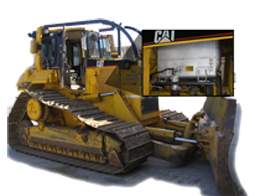


Reducing emissions from diesel engines is one of the most important air quality challenges facing the country. Even with EPA's more stringent heavy-duty highway and off-road engine standards set to take effect over the next decade, millions of diesel engines already in use will continue to emit large amounts of nitrogen oxides, particulate matter and air toxins, which contribute to serious public health problems.
BlueMAX™-Series - Technology
The main components of the BlueMAX™-Series system include the Selective Catalytic Reduction (SCR) catalytic converter, the computerized Urea Dosing System (UDS) and the urea tank (see diagram below). The urea control strategy relies on Nitrogen Oxides (NOx) concentration measurements by a sensor positioned upstream of the Selective Catalytic Reduction (SCR) catalyst. Based on the NOx sensor signal in combination with an engine air mass flow sensor and temperature sensors, the computer calculates the amount of urea which needs to be injected for optimum NOx reductions.
The NOx sensor-based control strategy makes the system very suitable for both original equipment and retrofit applications. System calibration (i.e. engine mapping) is not required and the system can be installed on a wide range of diesel engines, both mechanically and electronically controlled.



BlueMAX™-Series - Performance
Urea (in the form of a 32.5% water-based solution) is metered by a computer controlled dosing pump into the exhaust pipe upstream of the Selective Catalytic Reduction (SCR) catalyst through an injection nozzle. Compressed air from the air brake line or a standalone air compressor is used to atomize the urea for optimum dispersion, to maximize the Nitrogen Oxides (NOx) reductions and minimize the amount of urea required. The injected urea solution evaporates in the hot exhaust gas and decomposes producing ammonia. Through catalytic reactions with ammonia, NOx emissions are reduced to harmless products including nitrogen and water vapor.
The BlueMAX™-Series system includes an ammonia slip catalyst (oxidation catalyst) as a standard feature. The ammonia slip catalyst prevents the possibility that unreacted ammonia is released from the vehicle tailpipe. The catalyst consists of a metallic monolith honeycomb substrate coated with platinum group metal catalyst. The honeycomb structure with many small parallel channels presents a high catalytic contact area for the exhaust gases. Due to the presence of an oxidation catalyst reductions in Carbon Monoxide (CO) and Hydrocarbon (HC) emissions are achieved in addition to ammonia slip control. Typical conversion efficiency for NOx as well as for CO and HC are illustrated in the graphs below.






BlueMAX™-Series - Designs and Options
Standard models and sizing charts for the Nett BlueMAX™-Series system are listed in Table 1. Sizing for particular engines and applications should be consulted with our office before ordering.
Nett BlueMAX™-Series Standard Models (GL)
| Max. Engine Power | ||
| Model | hp | kW |
| GL5100 | 100 | 75 |
| GL5200 | 150 | 110 |
| GL5300 | 200 | 150 |
| GL5400 | 250 | 185 |
| GL5500 | 300 | 225 |
| GL5600 | 350 | 260 |
| GL5700 | 400 | 300 |
| GL5800 | 450 | 335 |
| GL5900 | 500 | 370 |
Custom housing designs are available to fit any engine configuration. The Nett BlueMAX™-Series Selective Catalytic Reduction (SCR) system can be supplied with a Diesel Particulate Filter (DPF) for simultaneous NOx and PM control (see BlueMAX™ PLUS, VOLT and NOVA models for more information).
BlueMAX™ 100 - Verification
Nett Technologies Inc. has received US-EPA verification of its BlueMAX™ 100 Selective Catalytic Reduction (SCR) system for controlling NOx emissions from mobile nonroad medium and heavy-duty diesel engines. The verification is a first of its kind issued for retrofit device under EPA ETV program (http://www.epa.gov/cleandiesel/verification/techlist-nett.htm)
Nett’s BlueMAX™-Series SCR system is designed to control Nitrogen Oxides (NOx) emissions. The system uses a urea control strategy that relies on a NOx concentration measurement by a sensor positioned upstream of the SCR catalyst. Based on the NOx sensor signal, in combination with an engine mass air flow sensor and temperature sensor, the necessary urea dosing rate is calculated by the control algorithm.
Feedforward NOx sensor-based control strategy, enables the system to be ideal for retrofit applications. The system can be installed on a wide range of diesel engines and no additional engine calibration is necessary. The Nett BlueMAX™-Series SCR system also controls Diesel Particulate Matter (DPM), Hydrocarbons (HC) and Carbon Monoxide (CO).
Verification testing, over two test protocols; NRTC and 8-mode steady test cycles conducted at the Southwest Research Institute proved that the system reduced NOx by 65%, PM by 12%. CO emissions were reduced by 92% and HC by 99%.
Nett’s BlueMAX™ 100 opens new opportunities to nonroad equipment users operating in nonattainment areas or where specified regulations exist for reducing NOx.
Nett is known for its ability to provide direct retrofit (catalyst assembly replaces the equipment’s original muffler) solutions in some of the most challenging configurations where the catalyst may be nearly four times the size of the original muffler through an integrated approach of design engineering and manufacturing. The Nett BlueMAX™-Serties SCR system is offered as a direct-fit design. This simplifies the installation and offers a customized cost-effective solution to a sophisticated emission control problem.


Reducing emissions from diesel engines is one of the most important air quality challenges facing the country. Even with EPA's more stringent heavy-duty highway and off-road engine standards set to take effect over the next decade, millions of diesel engines already in use will continue to emit large amounts of nitrogen oxides, particulate matter and air toxins, which contribute to serious public health problems.
Downloadable Documents
BlueMAX™ 100 Brochure (Off-road)BlueMAX™ -Series Folleto (Español)SCR Fact Sheet
Verification
Photo Gallery

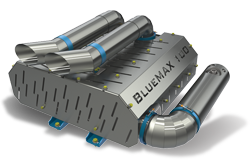 Great at reducing deadly emissions, such as Carbon Monoxide (CO), Hydrocarbons (HC) and Nitrogen Oxides (NOx) emissions from your diesel engine
Great at reducing deadly emissions, such as Carbon Monoxide (CO), Hydrocarbons (HC) and Nitrogen Oxides (NOx) emissions from your diesel engine

